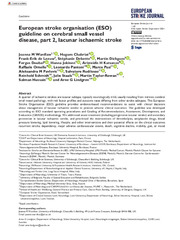Приказ основних података о документу
European stroke organisation (ESO) guideline on cerebral small vessel disease, part 2, lacunar ischaemic stroke
| dc.creator | Wardlaw, Joanna M | |
| dc.creator | Chabriat, Hugues | |
| dc.creator | de Leeuw, Frank-Erik | |
| dc.creator | Debette, Stéphanie | |
| dc.creator | Dichgans, Martin | |
| dc.creator | Doubal, Fergus | |
| dc.creator | Jokinen, Hanna | |
| dc.creator | Katsanos, Aristeidis H | |
| dc.creator | Ornello, Raffaele | |
| dc.creator | Pantoni, Leonardo | |
| dc.creator | Pasi, Marco | |
| dc.creator | Pavlović, Aleksandra | |
| dc.creator | Rudilosso, Salvatore | |
| dc.creator | Schmidt, Reinhold | |
| dc.creator | Staals, Julie | |
| dc.creator | Taylor-Rowan, Martin | |
| dc.creator | Hussain, Salman | |
| dc.creator | Lindgren, Arne G | |
| dc.date.accessioned | 2024-02-26T11:32:47Z | |
| dc.date.available | 2024-02-26T11:32:47Z | |
| dc.date.issued | 2024 | |
| dc.identifier.issn | 2396-9873 | |
| dc.identifier.uri | https://doi.org/10.1177/23969873231219416 | |
| dc.identifier.uri | internal-pdf://2338/Wardlaw et al. - 2024 - European stroke organisation (ESO) guideline on ce.pdf | |
| dc.identifier.uri | http://rfasper.fasper.bg.ac.rs/handle/123456789/5408 | |
| dc.description.abstract | A quarter of ischaemic strokes are lacunar subtype, typically neurologically mild, usually resulting from intrinsic cerebral small vessel pathology, with risk factor profiles and outcome rates differing from other stroke subtypes. This European Stroke Organisation (ESO) guideline provides evidence-based recommendations to assist with clinical decisions about management of lacunar ischaemic stroke to prevent adverse clinical outcomes. The guideline was developed according to ESO standard operating procedures and Grading of Recommendations, Assessment, Development, and Evaluation (GRADE) methodology. We addressed acute treatment (including progressive lacunar stroke) and secondary prevention in lacunar ischaemic stroke, and prioritised the interventions of thrombolysis, antiplatelet drugs, blood pressure lowering, lipid lowering, lifestyle, and other interventions and their potential effects on the clinical outcomes recurrent stroke, dependency, major adverse cardiovascular events, death, cognitive decline, mobility, gait, or mood disorders. We systematically reviewed the literature, assessed the evidence and where feasible formulated evidence-based recommendations, and expert concensus statements. We found little direct evidence, mostly of low quality. We recommend that patients with suspected acute lacunar ischaemic stroke receive intravenous alteplase, antiplatelet drugs and avoid blood pressure lowering according to current acute ischaemic stroke guidelines. For secondary prevention, we recommend single antiplatelet treatment long-term, blood pressure control, and lipid lowering according to current guidelines. We recommend smoking cessation, regular exercise, other healthy lifestyle modifications, and avoid obesity for general health benefits. We cannot make any recommendation concerning progressive stroke or other drugs. Large randomised controlled trials with clinically important endpoints, including cognitive endpoints, are a priority for lacunar ischaemic stroke. | |
| dc.language | en | |
| dc.publisher | Sage | |
| dc.relation | European Stroke Organisation, Basel, Switzerland. | |
| dc.rights | openAccess | |
| dc.rights.uri | https://creativecommons.org/licenses/by-nc/4.0/ | |
| dc.source | European Stroke Journal | |
| dc.source | European Stroke Journal | |
| dc.subject | Guideline | |
| dc.subject | systematic review | |
| dc.subject | stroke | |
| dc.subject | small vessel disease | |
| dc.subject | lacunar stroke | |
| dc.subject | alteplase | |
| dc.subject | thrombolysis | |
| dc.subject | antiplatelet | |
| dc.subject | antihypertensive | |
| dc.subject | lipid lowering | |
| dc.title | European stroke organisation (ESO) guideline on cerebral small vessel disease, part 2, lacunar ischaemic stroke | |
| dc.type | article | en |
| dc.rights.license | BY-NC | |
| dc.description.version | publishedVersion | |
| dc.citation.spage | 23969873231219416 | |
| dc.identifier.doi | 10.1177/23969873231219416 | |
| dc.identifier.fulltext | http://rfasper.fasper.bg.ac.rs/bitstream/id/11112/wardlaw-et-al-2024-european-stroke-organisation-(eso)-guideline-on-cerebral-small-vessel-disease-part-2-lacunar.pdf | |
| dc.type.version | publishedVersion |


